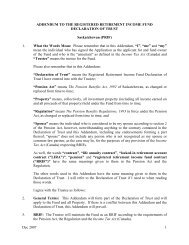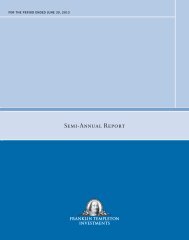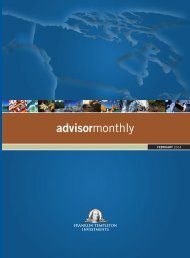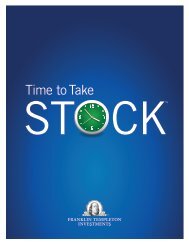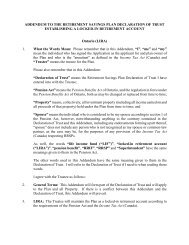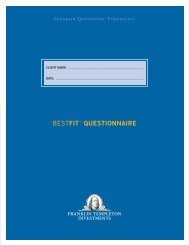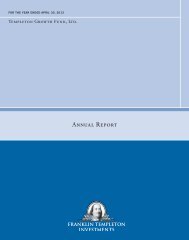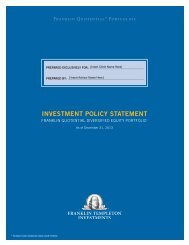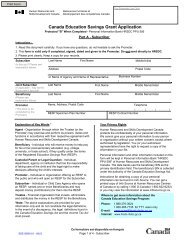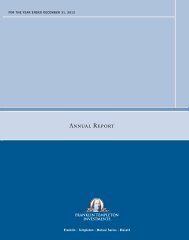Fair Value Measurements. The Company records substantially all of its investments in its financialstatements at fair value or amounts that approximate fair value. Fair value is defined as the price that wouldbe received to sell an asset or paid to transfer a liability in an orderly transaction between marketparticipants at the measurement date (the “exit price”). The Company uses a three-level fair value hierarchythat prioritizes the inputs to valuation techniques used to measure fair value based on whether the inputs tothose valuation techniques are observable or unobservable.The three levels of fair value hierarchy are set forth below. The Company’s assessment of thehierarchy level of the assets or liabilities measured at fair value is determined based on the lowest levelinput that is significant to the fair value measurement in its entirety.Level 1Level 2Level 3Unadjusted quoted prices in active markets for identical assets or liabilities.Observable inputs other than Level 1 quoted prices, such as quoted prices for similarassets or liabilities in active markets; quoted prices for identical or similar assets orliabilities in markets that are not active; or inputs other than quoted prices that areobservable or corroborated by observable market data. Level 2 quoted prices areobtained from independent third-party brokers or dealers, including prices derivedfrom model-based valuation techniques for which the significant assumptions areobservable in the market or corroborated by observable market data.Unobservable inputs that are supported by little or no market activity. These inputsrequire significant management judgment and reflect the Company’s estimation ofassumptions that market participants would use in pricing the asset or liability. Level3 valuations are derived primarily from model-based valuation techniques in whichone or more significant inputs are unobservable in the market.Trading securities, securities available-for-sale, and derivatives are financial instruments recorded atfair value on a recurring basis. The Company may also measure certain assets or liabilities at fair value on anonrecurring basis. These fair value measurements generally result from the application of lower of cost orfair value accounting for loans held for sale or write-downs of individual assets.Cash and Cash Equivalents include cash on hand, non-interest-bearing and interest-bearing depositswith financial institutions, federal funds sold, time deposits, securities of the U.S. Treasury and federalagencies, debt instruments with original maturities of three months or less at the purchase date, and otherhighly liquid investments, including money market funds, which are readily convertible into cash. Cash andcash equivalents are carried at cost. Due to the short-term nature and liquidity of these financial instruments,the carrying values of these assets approximate fair value.Investment Securities, Trading consist primarily of securities held by consolidated sponsoredinvestment products, non-consolidated sponsored investment products held for trading purposes, andretained subordinated securities and residual interests from securitization transactions. Changes in the fairvalue of these securities are recognized as gains and losses in earnings. The fair value of securities held byconsolidated sponsored investment products is primarily determined using quoted market prices, orindependent third-party broker or dealer price quotes. These securities are primarily classified as Level 1 orLevel 2. Consolidated sponsored investment products may also hold securities that are classified as Level 3because their fair value is determined using unobservable inputs. The fair value of these securities isdetermined using valuation methods as appropriate for each security type such as model-based valuations orprices of similar securities adjusted for illiquidity and credit risk factors. The fair value of non-consolidatedsponsored investment products is determined based on the published net asset values of the sponsoredinvestment products, and they are classified as Level 1. The fair value of retained subordinated securities74
from securitization transactions is determined using independent third-party broker or dealer price quotes,and these securities are classified as Level 2. The broker or dealer price quotes are evaluated forreasonableness based upon the performance of the underlying loans and comparable transaction pricing inthe securitization market. The fair value of residual interests currently is estimated using discounted cashflow analyses using unobservable inputs because recent economic conditions have significantly reduced thenumber of comparable securitization transactions. The residual interests are currently classified as Level 3.Investment Securities, Available-for-Sale consist primarily of non-consolidated sponsored investmentproducts and debt securities including U.S. government-sponsored enterprise obligations, securities of U.S.states and political subdivisions, securities of the U.S. Treasury and federal agencies, and corporate debtsecurities. Realized gains and losses are included in investment income using either the average cost methodor specific identification method. Unrealized gains and losses are recorded net of tax as part of accumulatedother comprehensive income until realized. The fair value of non-consolidated sponsored investmentproducts is determined based on the published net asset values of the sponsored investment products, andthey are classified as Level 1. The fair value of debt securities is determined using quoted market prices orindependent third-party broker or dealer price quotes, which are evaluated for reasonableness, and they aregenerally classified as Level 2, except for certain U.S. Treasury securities which are classified as Level 1.Other Investments are carried at cost. They consist of time deposits with financial institutions havingmaturities greater than three months but less than one year from the date of purchase. Due to the short-termnature and liquidity of these financial instruments, the carrying values of these assets approximate fairvalue.Investments in Equity Method Investees consist of equity investments in entities over which theCompany is able to exercise significant influence, but not control. Significant influence is generallyconsidered to exist when an ownership interest in the voting stock of the investee is between 20% and 50%,although other factors, such as representation on the investee’s board of directors and the impact ofcommercial arrangements, also are considered in determining whether the equity method of accounting isappropriate. Investments in limited partnerships and limited liability companies are accounted for using theequity method of accounting when the Company’s investment is considered to be more than minor. Equityinvestments are accounted for under the cost method if the Company is not able to exercise significantinfluence over the investee and the securities are not marketable.Impairment of Investments. The Company evaluates investments for other-than-temporary impairmenton a quarterly basis when the cost of an investment exceeds its fair value. For available-for-sale equitysecurities, the Company considers many factors, including the severity and duration of the decline in the fairvalue below cost, the Company’s intent and ability to hold the security for a period of time sufficient for ananticipated recovery in fair value, and the financial condition and specific events related to the issuer. Whenan impairment of an available-for-sale equity security is determined to be other-than-temporary, theCompany recognizes the impairment in earnings. For available-for-sale debt securities, if the Companyintends to sell or it is more likely than not that it will be required to sell a security before recovery of itsamortized cost, the Company records the entire impairment in earnings. If the Company does not intend tosell or it is not more likely than not that it will be required to sell the security before anticipated recovery ofits amortized cost, the Company separates the impairment into the amount of the total impairment related tothe credit loss and the amount of the total impairment related to all other factors. The credit loss componentis the difference between the security’s amortized cost and the present value of the expected cash flows. Thecredit loss component is recognized in earnings and the losses related to all other factors are recognized inaccumulated other comprehensive income.Derivatives. The Company enters into interest-rate swap agreements to mitigate interest rate exposurerelated to loans receivable, deposits, and debt of the banking/finance segment. At September 30, 2009, the75
- Page 1 and 2:
G A I N F R O M O U R P E R S P E C
- Page 3 and 4:
Letter to StockholdersGregory E. Jo
- Page 5 and 6:
LETTER TO STOCKHOLDERSHaving announ
- Page 7 and 8:
Directors and OfficersDirectorsChar
- Page 9 and 10:
Performance GraphThe following perf
- Page 11 and 12:
(MARK ONE)UNITED STATESSECURITIES A
- Page 14 and 15:
operational and other services requ
- Page 16 and 17:
A. Assets Under Management (“AUM
- Page 18 and 19:
60 days. If agreements representing
- Page 20 and 21:
Similar arrangements exist with the
- Page 22 and 23:
We generally operate our institutio
- Page 24 and 25:
Franklin Templeton Variable Insuran
- Page 26 and 27:
CATEGORY(and approximate amount of
- Page 28 and 29:
The following table sets forth the
- Page 30 and 31:
Korea; the Commission de Surveillan
- Page 32 and 33:
COMPETITIONThe financial services i
- Page 34 and 35: or other efforts successfully stabi
- Page 36 and 37: and, consequently, we are incurring
- Page 38 and 39: such as information, systems and te
- Page 40 and 41: like our business, is based in part
- Page 42 and 43: orrowing costs and limit our access
- Page 44 and 45: director of various subsidiaries of
- Page 46 and 47: PART IIItem 5. Market for Registran
- Page 48 and 49: OverviewWe are a global investment
- Page 50 and 51: Net income decreased in fiscal year
- Page 52 and 53: Investment Management Fee RateThe f
- Page 54 and 55: accounts closed in a calendar year
- Page 56 and 57: Information Systems, Technology and
- Page 58 and 59: Our investments in sponsored invest
- Page 60 and 61: At September 30, 2009, we had $355.
- Page 62 and 63: Off-Balance Sheet ArrangementsAs of
- Page 64 and 65: The fair value of retained subordin
- Page 66 and 67: Indefinite-lived intangible assets
- Page 68 and 69: the position will be sustained upon
- Page 70 and 71: Selected Quarterly Financial Data (
- Page 72 and 73: The following is a summary of the e
- Page 74 and 75: Item 8.Financial Statements and Sup
- Page 76 and 77: REPORT OF INDEPENDENT REGISTERED PU
- Page 78 and 79: CONSOLIDATED BALANCE SHEETS(dollars
- Page 80 and 81: CONSOLIDATED STATEMENTS OF STOCKHOL
- Page 82 and 83: CONSOLIDATED STATEMENTS OF CASH FLO
- Page 86 and 87: Company held interest-rate swap agr
- Page 88 and 89: not performed. If the carrying valu
- Page 90 and 91: Accumulated Other Comprehensive Inc
- Page 92 and 93: acquisition cost was allocated to t
- Page 94 and 95: FHLB borrowings and amounts availab
- Page 96 and 97: The Company recognized other-than-t
- Page 98 and 99: The changes in Level 3 assets measu
- Page 100 and 101: Changes in the allowance for loan l
- Page 102 and 103: Company sold retained subordinated
- Page 104 and 105: Certain of the goodwill and intangi
- Page 106 and 107: At September 30, 2009, maturities o
- Page 108 and 109: The components of the net deferred
- Page 110 and 111: At September 30, 2009, the banking/
- Page 112 and 113: Total assets under management of in
- Page 114 and 115: Stock OptionsThe following table su
- Page 116 and 117: The following tables summarize info
- Page 118 and 119: Operating revenues of the banking/f
- Page 120 and 121: minimum Tier 1 and Total risk-based
- Page 122 and 123: PART IIIItem 10. Directors, Executi
- Page 124 and 125: Item 15.(a)(1)(a)(2)(a)(3)PART IVEx
- Page 126 and 127: Exhibit No.Description10.17 Represe
- Page 128 and 129: Exhibit No.Description12 Computatio
- Page 130 and 131: Exhibit No.DescriptionEXHIBIT INDEX
- Page 132 and 133: Exhibit No.Description10.22 Amendme
- Page 134 and 135:
(dollars in thousands)COMPUTATION O
- Page 136 and 137:
NameState or Nation ofIncorporation
- Page 138 and 139:
CONSENT OF INDEPENDENT REGISTERED P
- Page 140 and 141:
EXHIBIT 31.2CERTIFICATIONI, Kenneth
- Page 142 and 143:
CERTIFICATION PURSUANT TO 18 U.S.C.
- Page 144:
One Franklin ParkwaySan Mateo, CA 9



